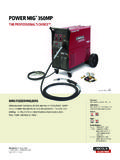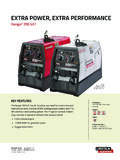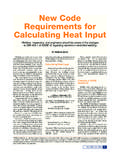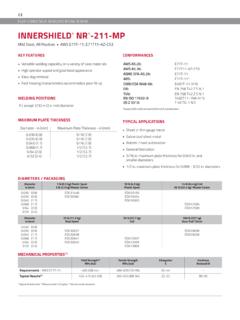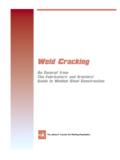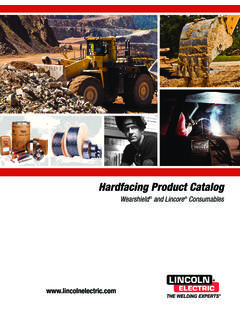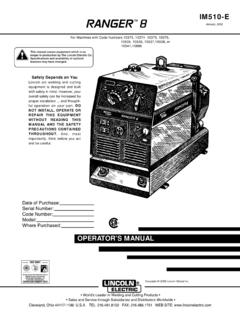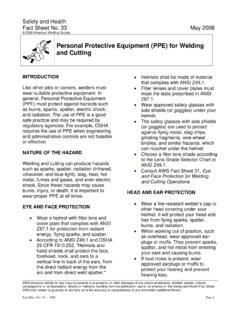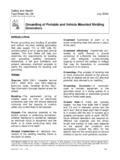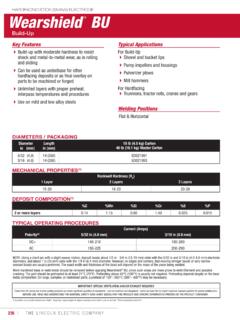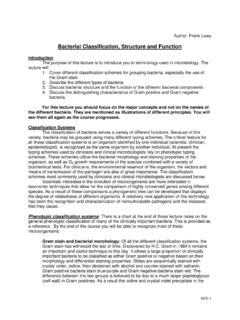Transcription of Welding Pressure Pipeliners and Piping Systems
1 Welding Pressure . PIPELINES &. Piping Systems . Procedures and Techniques Table of Contents Introduction ..3. Vertical Down vs. Vertical Up ..3-4. Cross Country Pipeline-Vertical Down Welding Joint Preparation ..4. Pipe End Cleaning ..4-5. Welding the Root Pass ..5-6. Current Settings w/Lincoln Engine Driven Welders .6-7. Root Pass Welding ..7. Root Pass Troubleshooting ..7. Techniques for Welding Hot Pass ..8. Techniques for Welding Fill and Cap ..8. Setting the Current etc..8-9. Preventing Cracking ..10. Techniques for X60 etc..10-11. Vertical Down Procedures ..12-13. Electrode Consumption ..14-15. Thin Wall Pipe Welding Procedures ..16-20. Double Ending ..20-21. Flux & Electrode Selection.
2 21. API Pipe Steel ..22-24. Consumables for Welding Pipe ..25. Consumables for High Strength Pipe ..26. Consumables for SMAW ..27-30. Consumables for FCAW ..30. Consumables for GMAW ..31. Pipe Welding Electrodes ..32-33. Mechanical Properties ..34-35. In-Plant Pipe ..36-37. Pipe Axis - Horizontal & Vertical ..38. Vertical Up Welding ..39. Vertical Up Electrode Consumption ..40-41. ASTM Pipe Steels ..42-43. -2- Introduction This booklet is a guide to Welding pipe with Shielded Metal Arc Welding (SMAW) and double ending pipe using automatic Welding . Lincoln Electric supplies electrodes, power sources, automatic and semiautomatic wire feeders, submerged arc wire and flux, which are the industry standards for pipeline construction around the world.
3 Semiautomatic, self-shielded flux-cored Innershield Process is being used around the world to produce high quality, low hydrogen, reliable, lower cost pipeline welds. Vertical Down vs. Vertical Up Welding Vertical down Welding with cellulosic electrodes is normally done with high currents and high travel speeds. Cellulosic electrodes have a thin coating containing a large amount of organic cellulose. When the electrode is burned, the coating forms a protective gas coating for the molten metal. Because of the organic material and the moisture content of these electrodes, they have a very strong arc force but at the same time the weld metal freezes very quickly. This method of Welding is fast and economical, consequently most cross country pipelines are welded with the progression vertically downward.
4 Impact toughness properties, which are very good may be met with modern cellulosic electrodes. Vertical up Welding with either cellulosic electrodes or low hydrogen electrodes is done with relatively low currents and low travel speed, which produce joints with relatively few, but large beads. -3- With low hydrogen vertical up electrodes, welds may be made virtu- ally free of slag entrapment and porosity. These welds are best able to meet strict radiographic requirements for high Pressure , high tem- perature or low temperature Piping . Because of the low hydrogen deposit, susceptible to CROSS COUNTRY PIPELINE. Vertical Down Welding Joint Preparation The joint preparation usually used for cross country pipeline is from API 1104 code.
5 As shown in the figure below, the normal situation is a penny land, penny gap , meaning that the land (root face) on the pipe should be ground to approximately the thickness of a penny [1/16 ( )]. The gap between pipes should be the same dis- tance, if possible. A 60 Included angle is used. +5. 30 0. Bevel Land T. 1/16". Gap 1/16". Pipe End Cleaning Pipe rarely will be received in a condition suitable for Welding . Generally, there will either be an oil or rust coating, or a coating to prevent corrosion. This could include paint, primer, varnish, epoxy, tar paper, or any variety of organic substances, all of which are undesir- able for Welding . Cleanliness is critical to prevent defects leading to rejected welds and costly repair, so these coatings must always be removed.
6 -4- these electrodes hydrogen cracking. have an advantage for high strength pipes The following are the guidelines to minimize Welding defects related to surface contamination: Moisture and condensation must always be removed prior to Welding . Both pipe ends must be cleaned, on the inside and the out- side, at least 1 (25mm) beyond the edge of the bevel. One recommended means of cleaning pipe is with a straight shaft grinder with a rubber expanding wheel and carbide coated sleeve. A sanding disc can also be effective, as well as an abrasive grinding disc. Depending on the pipe size, a half round file can be used to remove any burrs created when the land is ground on to the end of the pipe.
7 Welding the Root Pass Before beginning to weld the pipe, the procedure should be checked to assure that the correct electrode is being used. This includes the diameter and the classification of the electrode. The Welding con- sumable should be selected to correctly match (or overmatch) the strength of the pipe. Either Fleetweld 5P or Fleetweld 5P+ should be used for stringer bead and the hot pass when the hardness of the root pass is a con- cern, even if other higher strength consumables are to be used to fill and cap the weld. This softer root increases the resistance to cer- tain types of weld cracking. A number of factors will determine how many welders will be needed to weld the root pass.
8 In any case, it is best to have welders either (1) weld opposite one another or (2) evenly spaced around the pipe. This will minimize the amount of distortion in the pipe and prevent the gap from opening or closing. If possible, it is also desirable not to fin- ish a weld in exactly the bottom of the pipe because the tie-in can be more difficult. Similarly, it is best to avoid starting at exactly the top of the pipe (12 o'clock position). As a rule of thumb, for a 5/32 ( ) electrode, on the Welding time for one electrode should be approximately one minute and the length of weld should be approximately the same as the length of electrode consumed. This would produce a travel speed of approxi- mately 12 inches per minute, but this is extremely sensitive to joint preparation and exact Welding conditions.
9 The root pass is welded with a drag technique. The tip of the electrode is held in contact with both pipes and dragged around the circumfer- ence of the pipe, progressing vertically downhard. The electrode ini- tially should be held roughly perpendicular to the pipe. If there is a proper fit-up and the proper current is used, a small keyhole will be -5- seen following behind the electrode. If the keyhole is not seen, the electrode is not penetrating through to the inside of the pipe. The remedies for this would be: Higher current. Apply more Pressure on the electrode which lowers voltage and yields a colder puddle (depending on the type of Welding machine). Use a push angle (although this is not always advisable).
10 Slower travel speed. If the keyhole becomes too large and difficult to control, the remedies would be: Lower the current. Travel faster until the size of the keyhole decreases. Use more of a drag angle while using faster travel speed until the keyhole becomes more manageable. Apply less Pressure on the electrode which creates a bigger key- hole. The required current decreases as the gap size increases. If the gap is too narrow, it is not unusual to push so hard on the electrode that a 5/32 ( ) electrode will bend. Sometimes, because of magnetic conditions the arc will tend to push to one side of the joint. This is called arc blow. There are two solu- tions to this while Welding : 1) Put side Pressure on the electrode opposing the arc blowing tendency.
